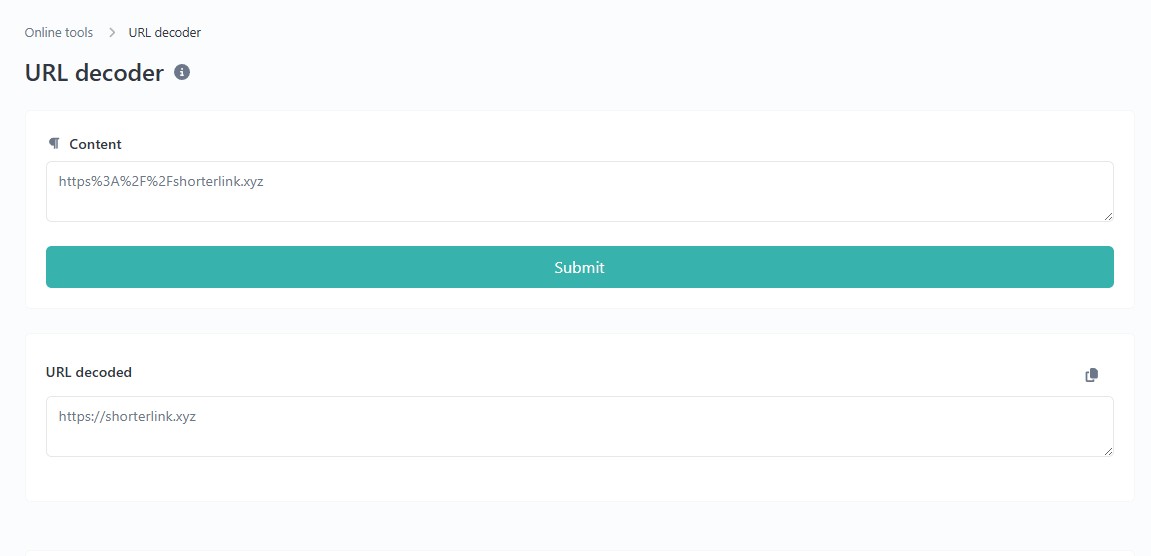
URL Decoder: Making Encoded Web Links Human-Readable Again
Created on 12 October, 2025 • Converter Tool • 0 views • 4 minutes read
Understand what a URL decoder is, how it works, and why decoding URLs is important for web development and user experience. Learn how shorterlink.xyz uses URL decoding to ensure clean, accurate redirects.
URLs are essential to how the web works. They carry information about destinations, parameters, and even user input. But often, URLs contain characters like %20, %3D, or %2F, which are unreadable for most people. These characters are part of URL encoding, used to safely transmit data over the internet. To understand and work with such URLs, we use a URL decoder.In this article, we’ll explain what a URL decoder is, how it works, and why decoding URLs is important. We’ll also look at how shorterlink.xyz uses URL decoding to ensure that shortened links remain accurate, secure, and easy to manage.
What Is a URL Decoder?
A URL decoder is a tool or process that converts encoded characters in a URL back to their original form. This is known as percent-decoding, where special characters are translated from their encoded format (e.g., %20) back to the original characters (e.g., a space).
For example:
%20 becomes a space
%3D becomes =
%2F becomes /
The main purpose of a URL decoder is to restore the readability and functionality of a URL that has been encoded, either manually or automatically by a system.
Why Is URL Decoding Important?
1. Human Readability
Encoded URLs can be difficult to read, especially if they contain many special characters. Decoding them turns %-encoded values into their original form, making the URL understandable to users and developers alike.
2. Accurate Data Retrieval
When data is passed through a URL (such as form inputs or search queries), it’s often encoded. Decoding ensures that the original input is recovered and interpreted correctly by the receiving server or application.
3. Debugging and Development
For developers working with APIs, dynamic URLs, or redirects, URL decoding is essential. It helps identify what data is being passed and whether it’s correctly formatted.
How Does URL Decoding Work?
URL decoding is based on a simple system called percent encoding. This system replaces characters that aren’t safe or allowed in URLs with a percent sign (%) followed by a two-digit hexadecimal number.
For example:
The character : is encoded as %3A
The character @ is encoded as %40
A URL decoder reverses this process by identifying the encoded segments and converting them back to their original characters.
The decoding process can be done manually using online tools or automatically through scripts and software built into web platforms—like shorterlink.xyz.
Real-World Uses of URL Decoding
Web Development and APIs
Many web apps and APIs transmit user inputs through URLs. For example, when a user searches for a term with a space, that space becomes %20. The receiving server decodes this value to retrieve the exact search term.
Email and Redirect Links
Links sent through email or shared across platforms may contain encoded parameters (such as user IDs, tokens, or tracking data). URL decoding helps systems interpret this data accurately.
QR Codes and Dynamic URLs
Encoded URLs are often used in QR codes and dynamic short links. When scanned or accessed, decoding restores the original information embedded in the link.
URL Decoding at shorterlink.xyz
At shorterlink.xyz, URL decoding is a vital part of the redirection process. When users create or access a shortened URL, it often includes encoded parameters, especially if the original link contains search terms, tracking tags, or special characters.
Here’s how URL decoding supports shorterlink.xyz:
Accurate Redirects: When a shortened URL is clicked, shorterlink.xyz decodes any parameters within the destination URL to ensure the user lands exactly where intended.
Readable Analytics: If tracking data or UTM codes are used, decoding helps present clean, readable reports for link performance.
Form and API Compatibility: When using shorterlink.xyz in automated systems or applications, decoding ensures that all data embedded in the URL is received in its proper format.
This behind-the-scenes process ensures every shortened link works perfectly, regardless of the complexity of the original URL.
Benefits of Using a URL Decoder
Clear and Understandable URLs
URL decoding removes the confusion caused by encoded characters, helping users and developers read and understand links more easily.
Improves Data Accuracy
Encoded inputs—such as names, values, or special symbols—are decoded to their original form, ensuring no data is lost or misinterpreted.
Useful for Debugging
When diagnosing link issues or API errors, decoding can reveal what data is actually being sent and received.
Limitations to Keep in Mind
While URL decoding is useful, it should be handled carefully:
Security Risks: Never decode untrusted or malicious URLs automatically, as this could expose vulnerabilities in a system.
Double Decoding: Decoding a URL that has already been decoded can cause errors. Systems must check the state of a URL before decoding it again.
By applying decoding correctly, you avoid data errors and improve reliability.
Conclusion
A URL decoder plays a crucial role in modern web development, communication, and data sharing. It helps convert encoded characters back to their original form, improving readability, functionality, and compatibility across different platforms.
At shorterlink.xyz, URL decoding ensures every shortened link remains accurate and user-friendly, even when complex parameters or special characters are involved. Whether you're a developer, marketer, or everyday user, understanding URL decoding empowers you to create, manage, and analyze web links with greater confidence.